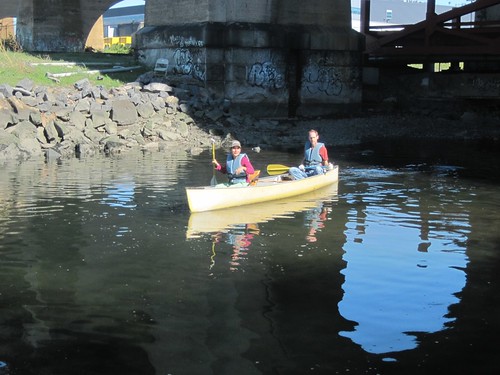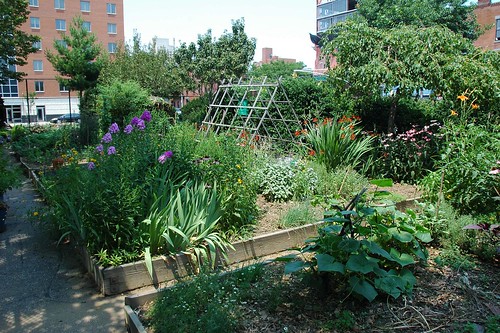








The city could be building a bridge to nowhere, thanks to a muddled South Bronx land deal.
The Randalls Island Connector, a planned pedestrian and bicycle bridge, will eventually span the Bronx Kill, a narrow waterway separating the South Bronx from public ball fields and green space on Randalls Island.
But land between the bridge and the South Bronx street grid is controlled by a private company, Harlem River Yards Ventures. The New York City Economic Development Corp. needs an easement so it can build a path from the bridge to E. 132nd St, according to the New York Daily News.
The EDC and HRYV have worked together on the project for years and now that the city is ready to start bridge construction, it has made the company an easement offer. But no deal has been struck and now the project is in doubt, sources said.
Anthony Riccio, senior vice president of HRYV, said negotiations are ongoing and claimed there is no cause for concern.
"There is no problem," he said. "We are confident we will reach a satisfactory resolution soon."
But the viability of the $6 million bridge is at stake, said an EDC spokesman.
The Connector will link the South Bronx to a greenway network that stretches from Randalls Island to Astoria, Queens and East Harlem.
We are hopeful that the negotiations with (HRYV) can be resolved quickly, so the city can move forward with this important project," said Kyle Sklerov, EDC spokesman, claiming the bridge will help South Bronx residents enjoy the outdoors.
The strip of land needed for the path is actually public property already, part of a sprawling 96-acre rail yard owned by the state Department of Transportation.
But HRYV controls the land because it secured a 99-year lease for the site in 1991 under terms later slammed by the state controller as a sweetheart deal.
Harry Bubbins, executive director of Friends of Brook Park, a South Bronx group, called the Connector "an extremely important" project with widespread community support. But he blasted the easement negotiations.
"The site belongs to the state. It is unfathomable why we even have to pay to use it and (HRYV) should expedite the easement."
The EDC and HRYV are also in talks about building a new headquarters for Fresh Direct at the rail yard. The Queens-based grocery delivery company is mulling a move to the site, with the EDC offering it millions of dollars in public benefits.
Despite the timing, Sklerov said the Connector and Fresh Direct projects are unrelated.
U.S. Rep. Jose Serrano (D-South Bronx) is betting on the Connector.
"I am confident any last minute problems will be worked out and this important project will move forward," he said.
Read More:
Two remarkable but unheralded Bronx sites could be remembered, restored and reborn thanks to recognition from a powerful advocacy group.
The Historic District Council this week recognized the Port Morris Gantries and Van Cortlandt Village as New York neighborhoods in need of preservation, according the New York Daily News.
"Neighborhoods throughout New York are fighting an unseen struggle to determine their own futures," said Simeon Bankoff, HDC executive director.
The soaring gantries arched cranes once used to lift ferry boats in and out of the East River could become the heart of a new waterfront plaza in gritty industrial Port Morris near E. 134th St.
Meanwhile, highlighting the rich history of middle-class housing in Van Cortlandt Village could help local residents beat back what they call inappropriate real estate development.
The sites were two of six recognized by the HDC this week. Last year, no sites honored by the nonprofit were in the Bronx. "To some degree, the Bronx is overlooked, said Bankoff, pledging to put the borough on the map."
Friends of Brook Park, a South Bronx community group, asked HDC to recognize the Port Morris Gantries. The group is working on a proposal for the redevelopment of the abandoned ferry terminal as a waterfront recreation and education center, said Harry Bubbins, executive director.
"We have no official public waterfront access along the coast of the South Bronx," said Bubbins. "The gantries are an example of the rich nautical history of New York and could become a bridge to future community use."

The Port Morris site was a ferry terminal from 1906 through the 1960s, carrying New Yorkers from the Bronx to Queens, Long Island and North Brother Island.
Used briefly as a police marina, the site is now mostly abandoned, and the gantries are decrepit and rusty. But the property is still owned by the city. Bankoff said HDC plans to help Friends of Brook Park gain access to the site for youth programs and boating.
In Van Cortlandt Village, the Fort Independence Park Neighborhood Association has been fighting a handful of land grabs and new housing projects.
The community sits atop the ruins of a Revolutionary War fort and was designed by legendary landscape architect Frederick Law Olmstead. It boasts small Tudor revival homes and during the 1920s became a mecca for socialist factory workers fleeing the tenements of the lower East Side to build cooperative housing.
Now that former co-ops such as the Shalom Aleichem Houses have fallen on hard times and the character of the neighborhood is threatened by overdevelopment, HDC will help FIPNA get it listed on the national historic register, said Kristin Hart, president of the community group.
“We want people who live here to know about and celebrate the great history of the neighborhood,” she said.


"Four years of tireless advocacy have paid off," said Harry Bubbins of Friends of Brook Park, calling the Bronx Kill a "tranquil and beautiful waterway."
The concrete-encased Con Ed cables span the strait near the RFK-Triborough Bridge. Only during low tide can canoes and kayaks squeeze under the cables, and then for no more than an hour, said Bubbins.
"They limit recreation and education by prohibiting the safe and easy passage of canoes and kayaks," he said.
But Con Ed is working with the city's Economic Development Corp. to remove the cables.
It recently built a trestle between the South Bronx and Randalls Island that will hold new cables and support a pedestrian and bicycle pathway, helping Bronx residents access Randalls Island.
Con Ed wouldn't set a time line for removing old cables, but Bubbins expects them to be gone within a year.
"We will continue to coordinate with Con Ed on the removal of the old conduit structure," said EDC spokesman Kyle Sklerov, calling the pathway a "key link in the city's greenway system."
Construction on the pathway is slated to begin next year.
Kayaks and canoes can already float from the East River to the Harlem River using the Hell Gate strait south of Randalls Island. But the route is less sheltered than the Bronx Kill and the water there is more turbulent.
Rob Buchanan, co-founder of the NYC Water Trail Association, called the planned Bronx Kill opening a "significant victory" andan outgrowth of the NYC Water Trail, a 2007 project that mapped local canoe and kayak launches and routes.
"The Bronx Kill is a really unique urban waterway that's very protected and kind of swirls through a bucolic landscape of green," said Buchanan. "It connects the Harlem River and the East River in a practical way."
He said the Water Trail Association hopes locals who learn to boat as kids will protect the city's waterways when they grow up.
Friends of Brook Park, in Mott Haven, leads kids on paddle tours to promote exercise and awareness of the environment.




Critics also contend that the lawsuit made it clear that community gardens were not standing in the way of affordable housing, as few, if any units of affordable housing have been created as a result, and there are numerous other avenues for the City to do so including renovating abandoned buildings city wide.
The community board also issued a strong statement regarding the lack of park maintenance and the need for increased spending:

Paul Revere, Rat Zoos and the GTL Index
New York Times - City Room Blog - July 28, 2010 - By J. David Goodman
